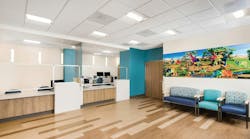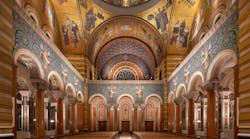The design team was comprised of experts in historic preservation, including lead architect Beyer Blinder and Belle and managing architect Ayers Saint Gross. Tillotson Design Associates provided the lighting design expertise, which included overseeing the custom replications of seven fixtures and the restoration of eight existing historic fixture. The lighting design also required the addition of a dozen modern fixtures—downlights, wall washers, task lights, etc.—to balance light levels and dramatically improve overall ambience.
Historic Look and Feel: The design team faced several obstacles when trying to recreate the lighting fixtures with a historically accurate aesthetic. “Many of the lost originals had to be newly designed by using historic photos as inspiration,” explains Suzan Tillotson, Tillotson Design Associates.
The Art Deco-style lighting fixtures first installed in the library were characterized by intricate detail work and decorative finials, which needed to be reconstructed correctly to effectively reproduce the historic look and feel of the space. For example, the diagram of the historic pendant, produced by Tillotson for the Pratt project, features several instances of spinnings and stamped or embossed banding.
Replicating the warm glow of incandescent lighting that filled the library interior in 1933 was another important aspect of the lighting design. The design team specified lighting sources with a correlated color temperature (CCT) of 2700K for use throughout the building including the Central Hall, North and South Reading Rooms, Children’s Creation Space, the Boardroom and even the Poe Room.
Beautiful and Better Performing: The design objectives for this project demanded that the lighting system achieve a historical accuracy, in terms of the aesthetic of the fixtures, and perform, in terms of light distribution, efficiency and control, in a way that reflects the capabilities of current and energy code-compliant technology. This required that the design team find a way to incorporate LED light sources into the historical replicas and effectively camouflage the more modern fixtures throughout the interior, so they could provide adequate levels of even illumination, without distracting from the historical nuance of the space. As Tillotson describes, “Another challenge lay in updating all the historic fixtures to contain LEDs, while carefully introducing minimal, standard fixtures and a new control system.”
There are several examples that illustrate how the lighting team effectively balanced historical accuracy with improved performance. The stunning daylight in the three-story Central Hall still contains the original glass installed in the 1933 building. It was cleaned and reinstalled during the renovation. The element was retrofitted with LED linear fixtures and daylight sensors to coordinate the level of artificial lighting with the presence of natural light, saving energy and preventing the space from being over lit.
Incorporating LEDs into the historic pendants and chandeliers made the fixtures more efficient but replacing the omnidirectional incandescent bulbs with directional LEDs also affected their lighting distribution. Tillotson and team added LEDs in layers of direct and indirect light. The more powerful, more efficient indirect light better highlights the ornate ceilings, while the enhanced direct light helps to meet illuminance targets at the floor and working surface. This strategy of customizing a distribution with direct and indirect layers of light was employed in all the renovated fixtures in the project. In the reading rooms, newly designed linear bronze stack and table lights were specified with careful attention to glare, optics and vertical footcandle levels.
Controls Story: The Pratt library reopened in September 2019, and, just as designed, it has been creating a sense of awe and wonder for visitors and members of the design community alike. The project has received several impressive accolades and recently won the IESNYC Lumen Citation for Historic Restoration and the 2021 IES Illumination Award of Merit.
Project Specs
Enoch Pratt Free Library, Baltimore, Md. // Architecture: Beyer Blinder and Belle, Ayers Saint Gross // Lighting Design: Tillotson Design Associates // Lighting Suppliers: Xicato; Philips; Specialty Lighting Industries; Lumenpulse; Lucifer; Litelab; USAI Lighting; and Circa Lighting.






